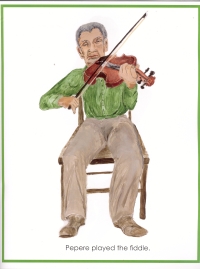| ________________
CM . . .
. Volume XIII Number 18 . . . . April 27, 2007
excerpt:
Once upon a time, many, many years ago, my mother taught at a one-room school in a very rural part of Manitoba. On some weekends, the school was used as the locale for a community dance. The desks were pushed to one end of the room in order to clear an open space for the dancers and the live musicians. As I was only about four or five, my memories are limited to some sensory impressions, one of them being the sound of the fiddle that called people to waltz, schottiche, polka, form squares or to engage in other dance forms. Consequently, when I picked up Linda Ducharme’s Pepere Played the Fiddle, its contents took me back to those earlier days when a fiddler and two or three other local musicians, not a music man with recorded music, were central to a successful social gathering. Pepere Played the Fiddle, which is told via poetry, is set in the past, but how far back is never directly identified in the main text. However, the opening illustration shows a man and two children arranging grain sheaves into stooks, and a later illustration includes the detail of a coal oil lantern hanging from a beam while a wood-fueled cook stove can be glimpsed though an open door. It was a time pre-televison when an evening’s entertainment required active participation rather than just passivity. Someone’s home was the gathering place as extended family members and friends came together. There was no separation of the generations, and the young were also naturally included:
The word “Pepere” in the title is not someone’s name. Rather, it is the Michif word for grandfather, Michif being the unique language of the Métis. A “Notes from the Author” page at the book’s conclusion provides some brief notes about the role that music, especially fiddling, played in traditional Métis life. This section also identifies the book’s setting to be the late 1940s, and it reveals that Ducharme researched the period so that her illustrations were accurate in their historic details. The other few Michif terms that are found in the text are also explained in the “Notes.” Ducharme’s acrylic paintings, while not sophisticated, are charming nevertheless, and they capture the shared joy of the music and the dancing. In addition to representing one of Canada’s cultural groups, Pepere Played the Fiddle could be used in an early years social studies class as a glimpse into an earlier period of Canadian social history. Recommended. Dave Jenkinson teaches at the Faculty of Education, the University of Manitoba in Winnipeg, MB.
To comment on this
title or this review, send mail to cm@umanitoba.ca.
Copyright © the Manitoba Library Association. Reproduction for personal
use is permitted only if this copyright notice is maintained. Any
other reproduction is prohibited without permission.
NEXT REVIEW |TABLE OF CONTENTS FOR THIS ISSUE
- April 27, 2007.
AUTHORS
| TITLES | MEDIA REVIEWS
| PROFILES
| BACK ISSUES
| SEARCH | CMARCHIVE
| HOME |

